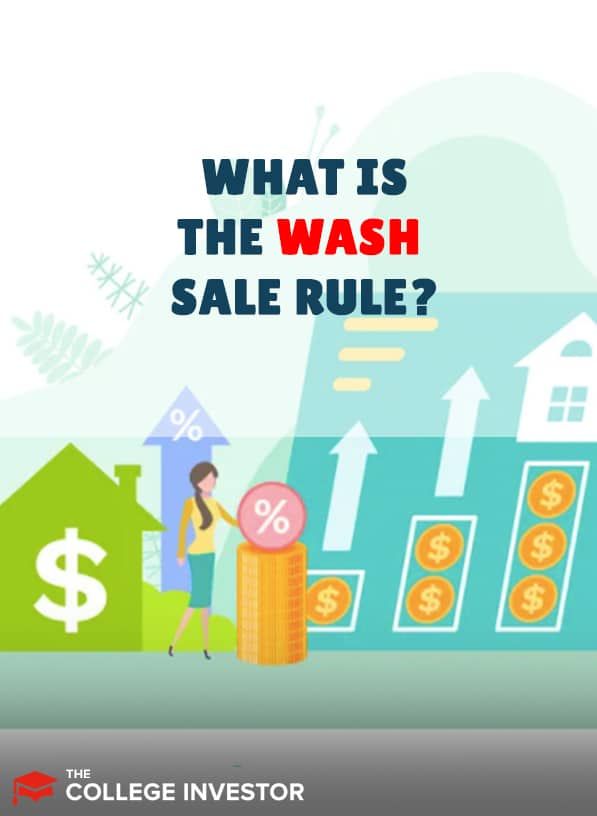
The wash sale rule has nothing to do with the max load of clothes that can be placed into a laundry machine. Instead, it’s a rule that limits what you can buy next after you sell a stock if you're hoping to harvest losses on the sale.
If you're a buy-and-hold investor who rarely sells investments, you're won't run against the wash sale rule very often. However, if you're a frequent trader or an investor who tries to do your own tax-loss harvesting, you'll want to be aware of the rules regarding wash sales so that you can avoid them as often as possible.
What Is The Wash Sale Rule?
The wash sale rule states that when you sell a stock for a loss, you can’t buy a substantially similar stock 30 days before or 30 days after the sale and claim the loss on your taxes. The restrictions on wash sales were added to keep investors from abusing tax-loss harvesting benefits.
Before the wash sale rule was put into place, investors could work the system to sell a security at a loss and then buy it back it the next day (or even just a few minutes later). Then on their year-end tax return, they could claim the realized capital losses on the sold and repurchased stock to offset capital gains on other stocks even though they hadn't truly left the position for a significant amount of time.
Today, if you do buy another security within 30 days before or after after selling one at a loss, it must be a "substantially different" one. Otherwise, you won't be able to claim the loss to reduce your taxable income. Also, your spouse or a company that you have a controlling interest in can’t buy a substantially similar stock.
Does The Wash Sale Rule Apply To Cryptocurrency?
Securities are subject to the wash sale rule. Examples of securities include stocks, ETFs, mutual funds, options, and bonds.
Currently, cryptocurrencies are considered property rather than securities (per §1091 of the IRS code) and thus are not subject to the wash sale rule. However, this may only be temporary.
As part of its review of the 2021 Infrastructure Bill, the Ways & Means Committee provided a summary document that provided several proposals for how the bill's initiatives could be funded. Included in the document (in Sec. 138153) are plans to subject cryptocurrencies to the wash sale rule:
Cryptocurrency traders and investors won't be happy to see this proposal. But it honestly makes sense as cryptocurrencies are bought and sold in a manner that more resembles stocks (with near-instant transactions) than tangible assets like real estate.
We'll have to wait to see if this modification to the wash sale rule ends up being added to the tax code. But if it does, exchanges will be subject to the same 1099-B reporting requirements that apply to stock brokers.
What About Wash Sales In An IRA or 401k?
The wash sale rule doesn't apply to tax-deferred retirement accounts like an IRA or 401k because the basis, gain, and individual transaction taxability doesn't matter.
In these accounts, you're only taxes when you withdraw the funds (and even then, only for traditional IRA and 401k accounts, and this is done at ordinary income tax rates).
As such, the individual transactions within the account don't matter for wash sale tax purposes. At the same time, it also doesn't really make sense to be conducting wash sales within these accounts anyway.
How Are Wash Sales Reported On Tax Returns?
If you do end up having a wash sale during the tax year, you'll report it on Form 8949 along with all of other capital assets that you held for less than one year. If you use tax software to prepare your return, make sure that the version that you use supports the tracking of capital gains and losses.
How To Avoid Wash Sales
The best way to avoid a wash sale is to simply wait until at least 30 days have elapsed before you buy a security again after selling it for a loss. But beyond this obvious answer, there are a few strategies that could allow you to re-enter the market sooner without violating the wash sale rule.
One option would be to buy another stock in the same sector. For example, if you sell Pfizer (PFE) at a loss, you could immediately buy Moderna (MRNA) without violating the wash sale rule. Or if you sold Procter & Gamble (PG), you could buy another stock in the Consumer Staples industry like Unilever (UL).
Another option is to rotate index ETFs that are similar but not identical. For example, you could sell shares of an S&P 500 ETF at a loss and then immediately buy shares of a Total Stock Market ETF. The performances of these types of funds have historically been very similar. But their underlying assets are different enough that they shouldn't be viewed as "substantially identical" securities.
One final option would be buy additional shares of a stock at least 31 days before you plan to sell some shares at a loss. For example, let's say you bought 20 shares of XYZ stock at $130 and it's currently selling at $100. If your long-term view of XYZ is bullish, you could buy an additional 20 shares of it at $100. Then 31 days later, you could sell your original shares and harvest their losses if the share price of XYZ is still below $130 at that time.
This last strategy is a bit riskier, however, as you'll be doubling your exposure to XYZ during the 30-day waiting period. If its share price continues to drop during that time, you'll be losing money on 40 shares instead of 20.
How Can Brokers Or Robo-Advisors Help?
Many brokerages and robo advisors provide management of the wash sale through their automated tax-loss harvesting algorithms. But you'll typically need to be invested in one of these firms' "managed portfolios" in order to take advantage of automatic tax-loss harvesting.
Note that not all brokers offer managed portfolios. For example, Robinhood and Webull don't. And even if robo-advisor portfolios are offered, that doesn't necessarily guaranteed that tax-loss harvesting will be included. SoFi Automated Investing, for example, doesn't offer tax-loss harvesting on its portfolios. And Wealthsimple only provides it to clients with over $100k of assets.
Still, several robo-advisors do include automated tax-loss harvesting to help clients avoid wash sales while minimizing taxes. Examples include Betterment, Wealthfront, and Axos Invest.
Final Thoughts
Even when avoiding the wash sale rule is automated, it's only automated at one firm. As mentioned above, if you invest across more than one brokerage or robo-advisor platform, you’ll need to track your wash sales across all of your accounts.
Working with a tax or financial advisor can help to better manage wash sales for those with multiple accounts. And if the wash sale rule ends up being applied to cryptocurrency as well, you may want to consider using a crypto tax software platform like CryptoTrader.Tax.

Robert Farrington is America’s Millennial Money Expert® and America’s Student Loan Debt Expert™, and the founder of The College Investor, a personal finance site dedicated to helping millennials escape student loan debt to start investing and building wealth for the future. You can learn more about him on the About Page or on his personal site RobertFarrington.com.
He regularly writes about investing, student loan debt, and general personal finance topics geared toward anyone wanting to earn more, get out of debt, and start building wealth for the future.
He has been quoted in major publications, including the New York Times, Wall Street Journal, Washington Post, ABC, NBC, Today, and more. He is also a regular contributor to Forbes.
Editor: Clint Proctor
